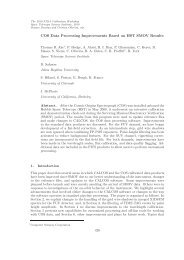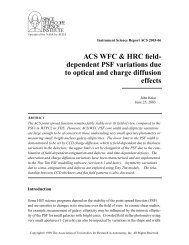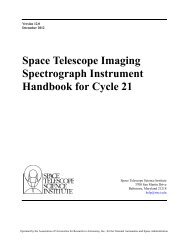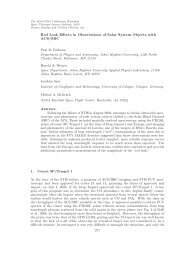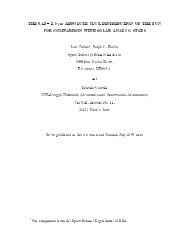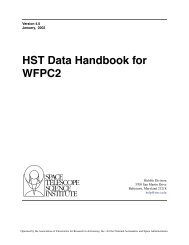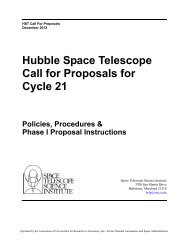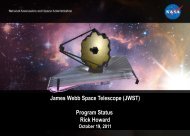STScI Annual Report 2002: A Living Mission
STScI Annual Report 2002: A Living Mission
STScI Annual Report 2002: A Living Mission
Create successful ePaper yourself
Turn your PDF publications into a flip-book with our unique Google optimized e-Paper software.
22 science essays<br />
Bar-Driven Evolution of Disk Galaxies Shardha Jogee<br />
Once considered anomalies, barred galaxies are now<br />
established as the norm, making up at least 70% of spiral<br />
galaxies in the local universe. As early as the 1880s,<br />
astronomers recognized large-scale bars, several kiloparsec<br />
(kpc) in size. These were further characterized later in<br />
the seminal works of Edwin Hubble and Gerard de<br />
Vaucouleurs. Today, we recognize that bars redistribute<br />
mass and angular momentum on all spatial scales by<br />
exerting gravitational torques and may well play a fundamental<br />
role in shaping the dynamical, morphological, and<br />
chemical evolution of local galaxies.<br />
A driving objective of astronomy is to chart the<br />
assembly and evolution of the diverse galaxies that lie<br />
along the Hubble sequence as well as the outliers with more<br />
irregular morphologies. Prominent in the Hubble and related<br />
hybrid classification schemes is a sequence of spiral<br />
galaxies that shows an increasingly prominent central<br />
condensation or bulge, a higher bulge-to-disk luminosity<br />
ratio, tighter spiral arms, and lower levels of star formation<br />
in the disk. Some studies contend that bars can cause<br />
these spiral galaxies to evolve along the Hubble sequence.<br />
Central to such secular evolution scenarios is the fact that<br />
large-scale bars efficiently transport molecular gas from<br />
the outer disk of a galaxy down to the inner few hundred<br />
parsecs (pc), increasing the central mass concentration.<br />
The ensuing high gas densities and short dynamical<br />
timescales in the inner region culminate in spectacular<br />
starbursts, which often dominate the luminosity of the<br />
entire galaxy. Using the Caltech’s Owens Valley Radio<br />
Observatory (OVRO) millimeter-wave array, the author and<br />
colleagues have mapped such gas-rich starburst rings<br />
near the dynamical resonances of barred galaxies (see<br />
Figure 1). Michael Regan and co-workers find similar<br />
features using the Berkeley Illinois Millimeter Array.<br />
The compact stellar disks or rings built by the<br />
bar-induced starbursts may account for some of the<br />
‘pseudo-bulges’ with exponential light profiles that Roelof<br />
de Jong and Marcella Carollo have identified in late-type<br />
galaxies. This echoes an earlier idea of John Kormendy,<br />
that certain bulges may in fact be closer to disks.<br />
Furthermore, ‘real’ spheroidal bulges may also be built via<br />
bending instabilities, vertical bar resonances, and chaotic<br />
orbits that drive stars well above the plane of the disk.<br />
Observed boxy bulges and peanut-shaped bars could be<br />
intimately linked to such processes. Simulations even suggest<br />
that after a bar raises the central mass concentration<br />
above a critical level, it can weaken and self-destruct into<br />
a large bulge! This could transform a strongly barred<br />
spiral into a weakly barred or even unbarred galaxy.<br />
Yet, our understanding of bars is far from set in stone<br />
and unanswered questions remain. Can a disk regenerate<br />
a bar once it has been destroyed, or will the inhospitable<br />
conditions left behind—such as a large central concentration<br />
and a hot disk—inhibit any subsequent bar formation?<br />
How are bars influenced by the external environment,<br />
particularly in the early universe, when interactions with<br />
both small and large galaxy companions may have been<br />
more frequent? Does the fate of bars change dramatically<br />
when they are embedded in halos that are responsive and<br />
triaxial rather than rigid and spherical?<br />
In the last decade, Hubble and high-resolution,<br />
ground-based, near-infrared images have brought attention<br />
to a new component of disk galaxies: small-scale<br />
nuclear bars—typically kpc or sub-kpc in size—nested<br />
Figure 1: At left, the Hubble<br />
Wide Field Planetary Camera<br />
2 composite of the barred<br />
galaxy NGC 4314 showing a<br />
spectacular ring of star formation<br />
and young compact<br />
star clusters in the inner few<br />
hundred parsecs. At right, the<br />
OVRO carbon monoxide map<br />
shows that this ring contains<br />
hundreds of millions of solar<br />
masses of molecular hydrogen,<br />
which have piled up near<br />
the dynamical resonances of<br />
the bar. (Hubble image courtesy<br />
of Zolt Levay and Fritz<br />
Benedict.)





